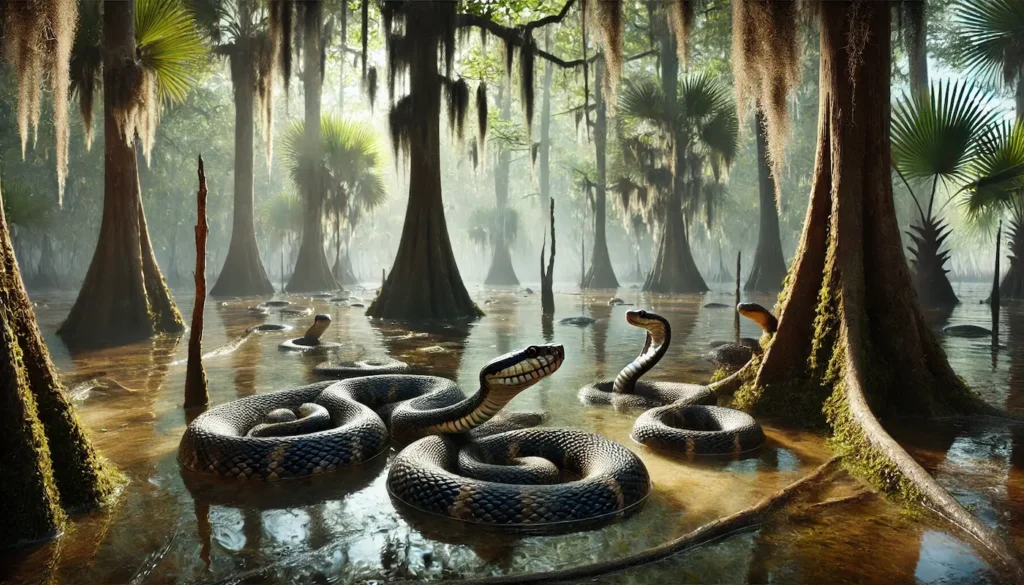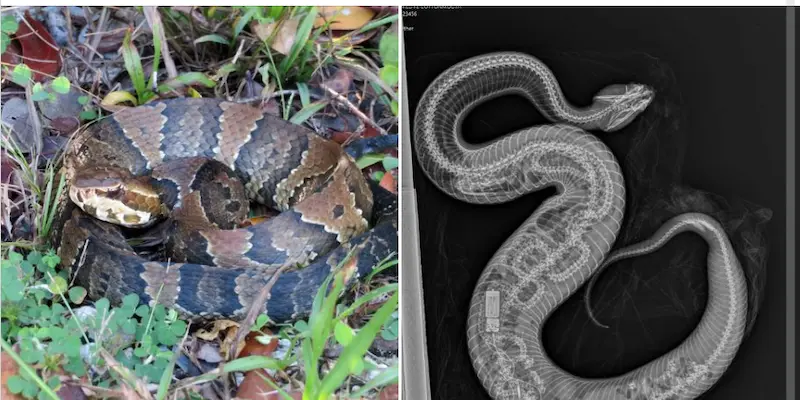|
Getting your Trinity Audio player ready... |
Tabla de Contenido/ Table of Contents
- 1 Powerful New Predator Targets Burmese Pythons in Florida Everglades. The new predators are cottonmouth snakes.
- 1.1 Introduction
- 1.2 The Burmese Python Problem in the Everglades
- 1.3 The Role of Cottonmouths as Python Predators
- 1.4 Characteristics of Cottonmouth Snakes
- 1.5 Other Species That Prey on Pythons
- 1.6 Tracking Technology: A Key Element in the Study
- 1.7 Ecological Impact of the Burmese Python
- 1.8 Efforts and Challenges in Eradicating Burmese Pythons
- 1.9 Future Possibilities and Ongoing Studies
- 1.10 Conclusion
- 1.11 Frequently Asked Questions
Powerful New Predator Targets Burmese Pythons in Florida Everglades. The new predators are cottonmouth snakes.
Introduction
The Florida Everglades have been fertile ground for environmental challenges due to the accidental introduction of Burmese pythons, an invasive species that has disrupted the delicate balance of this valuable ecosystem. Recently, researchers discovered a surprising fact: cottonmouth snakes (also known as water moccasins) are helping control the population of young pythons, acting as a new predator in the Everglades food chain. This article explores the interaction between these two species, ongoing conservation efforts in the area, and new findings that may help mitigate the impact of Burmese pythons on this ecosystem.
The Burmese Python Problem in the Everglades
Since their introduction to South Florida decades ago, Burmese pythons have spread throughout the Everglades, devastating native wildlife. These large snakes have drastically reduced populations of mammals like raccoons, foxes, rabbits, and white-tailed deer. According to the United States Geological Survey (USGS), pythons are responsible for declines of 85% to 100% in certain mammal species, directly competing with native predators for both resources and territory.

The Role of Cottonmouths as Python Predators
A recent USGS study revealed that cottonmouth snakes, present in the swamps and wetlands of the Everglades, are playing an unexpected role in controlling young python populations. These venomous snakes have started hunting and consuming young pythons, a discovery that brings hope to scientists and conservationists working to restore the ecological balance in the area.

Characteristics of Cottonmouth Snakes
Cottonmouths, also known as water moccasins, are distinguished by their robust bodies and dark coloration. They get their common name from the distinctive white interior of their mouths, which they expose as a warning when threatened. Cottonmouths primarily inhabit wetlands, though they can occasionally venture into other habitats near water. Opportunistic hunters, they feed on a wide variety of prey, including frogs, fish, birds, and small mammals. Adding young pythons to their diet represents a natural adaptation that may significantly aid in managing the invasive species’ population.
Other Species That Prey on Pythons
In addition to cottonmouths, other native predators, including American alligators, red lynxes, and Gulf Coast indigo snakes, are also known to prey on Burmese pythons. There are even reports that Florida black bears might consume pythons. This interaction between pythons and native predators suggests a slowly adjusting food web that could naturally mitigate the python’s impact as an invasive species.
Tracking Technology: A Key Element in the Study
The discovery of cottonmouths as python predators was made possible thanks to tracking technology. In 2022, Zoo Miami implanted a tracking transmitter in a Burmese python, allowing researchers to monitor its movement. Surprisingly, when the team checked the transmitter’s location, they found that the python had been consumed by a cottonmouth. This event was captured in an X-ray image showing the transmitter inside the venomous snake’s stomach, revealing a new perspective on the interaction between the two species.

Additional Source: New Findings on Python Predation in the Everglades
A December 2021 study published in Herpetological Review by Ian Bartoszek and a team from the Conservancy of Southwest Florida, the United States Geological Survey (USGS), and the U.S. Fish and Wildlife Service, further investigates the predation of Python bivittatus (Burmese Python) in Florida. This report, titled Natural History Note: Agkistrodon conanti (Florida Cottonmouth) and Python bivittatus (Burmese Python) – Diet and Predation, highlights several native predators preying on Burmese pythons, including the American alligator (Alligator mississippiensis), the Gulf Coast Indigo Snake (Drymarchon couperi), the Bobcat (Lynx rufus), and potentially the Florida Black Bear (Ursus americanus floridanus). These species have been documented consuming juvenile pythons, contributing naturally to efforts to control the python population in the Greater Everglades Ecosystem.
The study records mortality events of young pythons, specifically hatchlings and juveniles, tracked via radiotelemetry. This monitoring method provided insight into the interactions and predation risks that young pythons face in the wild. The findings offer additional evidence that native Everglades species are beginning to incorporate Burmese pythons into their diets, which may help mitigate the impact of this invasive species on the region’s biodiversity.
This source adds depth to our understanding of the predation dynamics in the Everglades, suggesting that native predators like the Florida cottonmouth and other species may gradually help to restore ecological balance.
Ecological Impact of the Burmese Python
Burmese pythons have profoundly affected the Everglades’ ecosystem, especially among mammals and birds. The pythons’ introduction, attributed to intentional releases and accidental escapes, allowed them to establish a breeding population that has grown unchecked. As a result, they now compete fiercely for resources and territory with native predators, significantly altering the Everglades food chain.
Efforts and Challenges in Eradicating Burmese Pythons
Eradicating Burmese pythons from the Everglades has proven almost impossible. Despite efforts to capture and eliminate the snakes, the species continues to thrive in the swampy habitat. The USGS has pointed out that this situation represents one of the most challenging invasive species control efforts in the world. Various hunting and removal methods have been implemented, including python capture competitions, but while helpful, these efforts are insufficient to fully eradicate the species.
Future Possibilities and Ongoing Studies
The discovery that cottonmouths and other native species prey on young Burmese pythons opens new opportunities for exploring natural solutions to the problem. Scientists are considering how these interactions could inform ecological management strategies. This might include protecting and promoting these natural predators as allies in the fight against the Burmese python.
Conclusion
Recent findings that cottonmouths are preying on young Burmese pythons in the Everglades suggest that nature may be developing mechanisms to rebalance the ecosystem. Although a complete eradication of Burmese pythons remains unlikely, the presence of native predators willing to consume this invasive species offers a glimmer of hope. These discoveries emphasize the importance of continued ecological research and the implementation of innovative solutions to preserve the Everglades’ natural balance.
Frequently Asked Questions
1. Why are Burmese pythons a threat in the Everglades?
Burmese pythons are invasive and have few significant natural predators, allowing them to thrive and consume large numbers of native animals, disrupting the ecosystem’s balance.
2. What are cottonmouth snakes?
Cottonmouths are venomous snakes that inhabit Florida’s wetlands, known for their aggression and ability to hunt a wide range of prey, including young pythons.
3. Is it possible to eradicate Burmese pythons from the Everglades?
Experts believe it’s unlikely to eradicate them fully due to their rapid reproduction and adaptability to the environment, but control efforts are ongoing.
4. What technology is used to monitor Burmese pythons?
Tracking transmitters are used to follow the pythons in real time, leading to discoveries about interactions between pythons and other species.
5. Which other species help control the python population?
In addition to cottonmouths, native species like American alligators, red lynxes, and some other predators also consume pythons, helping to reduce their numbers.
6. How do Burmese pythons impact the native fauna in the Everglades?
Pythons have drastically reduced mammal and bird populations, affecting the biological diversity of the area.
Want more post like this?
Head over to our homepage for the latest updates from South Florida and beyond:








